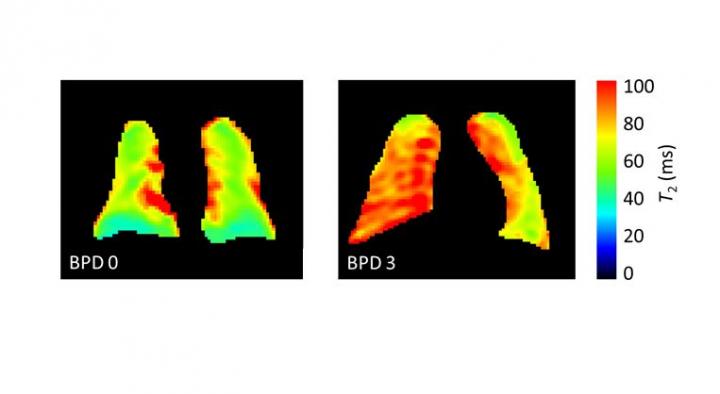
Credit: © Klinikum Universität München
Infants born prematurely frequently develop a form of chronic lung disease known as Bronchopulmonary Dysplasia. Previously, this disease could only be diagnosed clinically and with a low degree of differentiation. Researchers at the Helmholtz Zentrum München and the University Hospital of the Ludwig-Maximilians University – partner in the German Center for Lung Research (DZL) – have now successfully developed a new protocol for identifying neonatal patients with the disease by the use of magnetic resonance imaging (MRI).
Their findings have now been published in Thorax.
Between 15 and 30 percent of all preterm babies with a birth weight of less than 1000 grams or who are born before the 32nd week of pregnancy develop Bronchopulmonary Dysplasia1. Depending on disease severity, BPD can lead to lung dysfunction that continues into adulthood, and in some cases also leads to death. “Up until now it has only been possible to diagnose according to clinical criteria that only allow for a low degree of differentiation ,” reports Dr. Anne Hilgendorff, head of the working group “Mechanisms of Neonatal Chronic Lung Disease” at the Institute of Lung Biology (ILBD) and the Comprehensive Pneumology Center (CPC) at the Helmholtz Zentrum München and Director of the Center for Comprehensive Developmental Care (CDeCLMU) providing care for high-risk preterm and term neonates at Munich University Hospital (LMU). Dr. Hilgendorff: “Up to now there has been a lack of specific options for assessing structural changes in the lungs while avoiding the harmful effects of radiation, and this has made personalized treatment and follow-up monitoring more difficult.” A new MRT protocol could now close this gap.
Study involving 61 at-risk patients
“With our team of scientists2 in closest collaboration with our clinical colleagues in the Perinatal Center at the LMU and the Department of Radiology we have evaluated the imaging studies of 61 neonates,” reports Dr. Kai Förster, a physician-scientist in Dr. Hilgendorff’s working group. All the infants involved in the study were born before the 32nd week of pregnancy. During the examination, which took place close to the date of birth, they were already able to breathe independently and underwent MRI scanning during spontaneous sleep. Statistical analysis of the MRI data performed by colleagues from the Institute for Computational Biology at the Helmholtz Zentrum revealed increased T2 and decreased T1 relaxation times3, indicating the presence of Bronchopulmonary Dysplasia. “Our results mark an important step towards improving image-based phenotyping of infants who are at risk or have developed the disease,” comments Dr. Hilgendorff. “In future, individual treatment and monitoring strategies will thus be possible.” It is important, she stresses, that large perinatal centers now use this method and evaluate it jointly aiming at identifying potential subtypes of Bronchopulmonary Dysplasia.
###
Contact for the media:
Abteilung Kommunikation, Helmholtz Zentrum München – Deutsches Forschungszentrum für Gesundheit und Umwelt (GmbH), Ingolstädter Landstr. 1, 85764 Neuherberg – Tel. +49 89 3187 2238 – E-Mail: [email protected]
Scientific Contact:
PD Dr. Anne Hilgendorff, Helmholtz Zentrum München – Deutsches Forschungszentrum für Gesundheit und Umwelt (GmbH), Institut für Lungenbiologie & Comprehensive Pneumology Center, Max-Lebsche-Platz 31, 81377 München – Tel. +49 89 3187 4675 – E-Mail: [email protected]
Further information
Original publication
Förster K et al. (2019), Altered Relaxation Times in Magnetic Resonance Imaging Indicate Bronchopulmonary Dysplasia. Thorax. DOI: 10.1136/thoraxjnl-2018-212384
1 Bronchopulmonary dysplasia (BPD) is thought to be caused by various risk factors such as inflammatory processes, microtrauma resulting from ventilation therapy and toxicity induced by oxygen free radicals, which damage a baby’s immature lung. In the long term, the tissue, which is important for pulmonary gas exchange, becomes damaged and scarred.
2 Scientists from the Institute of Computational Biology (Helmholtz Zentrum München), the Department of Radiology (LMU Munich) and the Perinatal Center, Campus Grosshadern (LMU Munich) critically contributed to the study.
3 Magnetic resonance imaging (MRI) works on the principle that hydrogen nuclei are comparable to small magnets. In a strong external magnetic field, they align either in parallel or anti-parallel to this field. When energy is applied in the form of radio frequency (RF) pulses, almost all of the hydrogen nuclei briefly align with the direction of the field. They then release this energy and lose their orientation. Two independent processes – t1 and t2 relaxation – describe this process. MRT does not involve the use of X-rays.
As German Research Center for Environmental Health, Helmholtz Zentrum München pursues the goal of developing personalized medical approaches for the prevention and therapy of major common diseases such as diabetes mellitus and lung diseases. To achieve this, it investigates the interaction of genetics, environmental factors and lifestyle. The Helmholtz Zentrum München has about 2,300 staff members and is headquartered in Neuherberg in the north of Munich. Helmholtz Zentrum München is a member of the Helmholtz Association, a community of 18 scientific-technical and medical-biological research centers with a total of about 37,000 staff members. http://www.
The Comprehensive Pneumology Center (CPC) is a joint research project of the Helmholtz Zentrum München, the Ludwig-Maximilians-Universität Clinic Complex and the Asklepios Fachkliniken München-Gauting. The CPC’s objective is to conduct research on chronic lung diseases in order to develop new diagnosis and therapy strategies. The CPC maintains a focus on experimental pneumology with the investigation of cellular, molecular and immunological mechanisms involved in lung diseases. The CPC is a site of the Deutsches Zentrum für Lungenforschung (DZL). http://www.
The German Center for Lung Research (DZL) pools German expertise in the field of pulmonology research and clinical pulmonology. The association’s head office is in Giessen. The aim of the DZL is to find answers to open questions in research into lung diseases by adopting an innovative, integrated approach and thus to make a sizeable contribution to improving the prevention, diagnosis and individualized treatment of lung disease and to ensure optimum patient care. http://www.
Munich University Hospital (LMU) treats around 500,000 outpatients, inpatients and semi-residential patients each year at its Großhadern and City Centre Campuses. Just over 2,000 beds are available to its 29 specialist clinics, twelve institutes and six departments, and its 49 interdisciplinary centres. Of a total of 9,450 employees, around 1,600 are doctors and 3,200 are nursing staff. Munich University Hospital has been a public-law institution since 2006. Together with the Medical Faculty of Ludwig Maximilians University, Munich University Hospital is involved in four special research areas of the German Research Foundation (SFB 684, 914, 1054, 1123), three Transregios (TRR 127, 128, 152) belonging to Clinical Research Group 809, and two Graduate Colleges belonging to the German Research Foundation (GK 1091, 1202). This is in addition to the Center for Integrated Protein Sciences (CIPSM), Munich Center of Advanced Photonics (MAP), Nanosystems Initiative Munich (NIM) and Munich Cluster for Systems Neurology (SyNergy) – all institutes of excellence – and the Graduate School of Systemic Neurosciences (GSN-LMU), the Graduate School of Quantitative Biosciences Munich (QBM) and the Graduate School Life Science Munich (LSM). http://www.
Media Contact
Evangelos Papagrigoriou
[email protected]
Original Source
https:/
Related Journal Article
http://dx.




